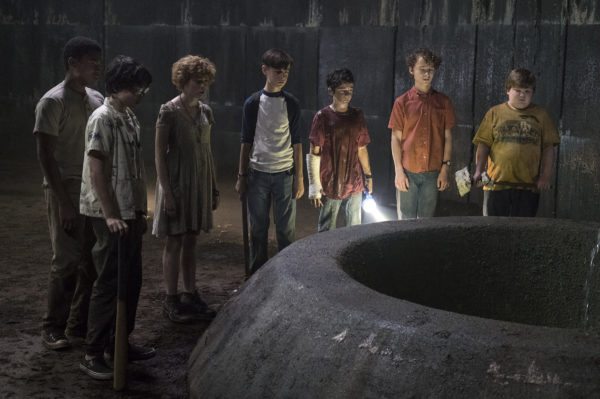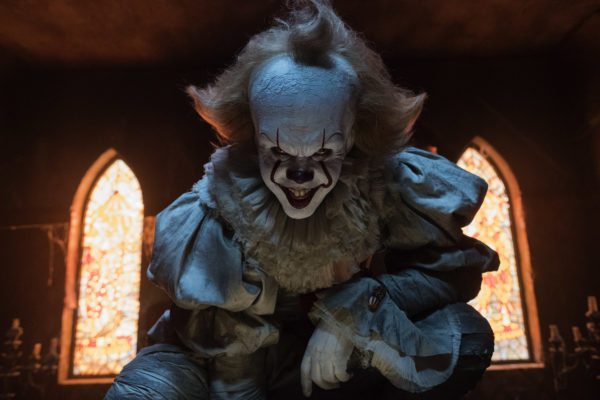It, 2017.
Directed by Andy Muschietti.
Starring Bill Skarsgard, Jaeden Lieberher, Sophia Lillis, Finn Wolfhard, Jeremy Ray Taylor, Nicholas Hamilton, Jack Dylan Grazer, Stephen Bogaert, Jackson Robert Scott, Chosen Jacobs, Wyatt Oleff, Jake Sim, Owen Teague, Stuart Hughes, Logan Thompson, Geoffrey Pounsett, Pip Dwyer, and Javier Botet
SYNOPSIS:
A group of bullied kids band together when a monster, taking the appearance of a clown, begins hunting children.
Considering the less than stellar track record of Stephen King adaptations (including the recently released monumental failure that is The Dark Tower), it’s pleasant to report that director Andy Muschietti’s (Mama) stab at one of the writer’s most revered works of art doesn’t float like a lifeless corpse down in Pennywise’s sewer lair, but instead propels forward with frightful momentum and probably the best character work that could be done when bringing such a lengthy and detailed story to the silver screen. Not to draw comparisons to the two, as Tim Curry’s interpretation of the flesh and fear feasting demonic clown will always be one of the high spots in regards to King’s imagination translated to cinema, but this is both a film with its own identity (the events unfold throughout the late end of the 1980s this time around) that also manages to honor the craftsmanship that went into one of the novelist’s most personal tales.
Paramount to the film’s success at actually making audiences care about the lives of these innocent middle-schoolers, Muschietti skillfully introduces each member of the Losers Club with natural flow and transitions, wisely spending a good amount of time following the various students around on the last day of school. Some scenes are even interwoven into others, sidestepping the pitfall of editing being multiple disjointed scenes delivering backstory painfully slow by one kid at a time. The downfall is that (with the exception of Beverly whose character absolutely needs those disturbing moments revealed) not much time is spent at home with the parents, when their misunderstanding nature or abusive nature towards their children is one of the greater themes explored in the novel, and more importantly, one of the most crucially binding factors in the children’s friendship.
However, there is a great deal of bullying going on (another common trait that brings the kids together), but it does come across as comically over-the-top. Partially, this is due to the fact that the bullies, including their downright psychopathic leader, are completely one-dimensional with no explained motives for their aberrant violence. There is one scene alluding to a rough childhood upbringing, but the determination and lengths these delinquents will go to just to dish out some brutality are far-fetched. When homemade flame throwers are being brought into the mix, it’s all just a bit too much. Basically, it would have been nice if they were humanized and not caricatures of extremely violent bullies. Furthermore, if some time away from these pointless characters is stripped away, maybe there is more of an opportunity to dive into the relationships the parents and children hold.
Anyway, the glue holding the Losers Club together, and by extension, the entire film is the camaraderie between the middle schoolers. They are all outcasts in some form or another whether it be a stutter, asthma, OCD cleanliness panic attacks, or an overweight body build, naturally embracing the company of one another. Obviously, considering that they are just entering their teenage years, the dialogue exchanges between them tend to be juvenile, crass, and even sexual, but it’s all easily a positive because it feels like real behavior. Their friendly love for one another and adventure of attempting to solve a mystery and defeat a freakish clown seemingly from the lowest depths of hell come across as the kind of movie magic found in The Goonies… just with lots more strong cursing and adult references. Circling back around to the common theme of being ostracized, the group does have a single female companion, the aforementioned Beverly, dealing with some horrific living circumstances that shape her into being the empathetic and genuinely sincere person she is that actually wants to associate with these so-called losers.
With all that said, it additionally needs to be mentioned that the cast from top to bottom does a fantastic job, with special shout outs to Jaeden Lieberher (his stuttering feels authentic and never once awkward from an acting perspective), Sophia Lillis (even though life at home is only explored at a surface in-your-face level, she is terrific at presenting the emotional pain boiling within her yet also hiding it from the rest of the club, as emotionally traumatized people tend to do), Finn Wolfhard (the jokester of the group that provides the majority of the comedic relief), Jeremy Ray Taylor (there’s something to deeply appreciate about a chubby kid slowly but surely coming into himself as he gains friends, that also chases the affection of the prettiest girl his age), and Bill Skarsgard’s Pennywise.
Yes, it’s finally time to discuss the terrifying devourer of children. From his introduction, it’s evident the filmmakers have decided to go for broke presenting him physically as the personification of pure evil. For whatever reason, many people have a phobia of clowns, so I can’t even imagine what this depiction of Pennywise, an actual disgusting looking clown, will do to those same unfortunate souls. This is all balanced with a conniving and persuasively kind voice, all with a dash of sinister intentions (the mixed tones to the performance is actually outstanding ) to lure children into his filthy sewer abode.
When not in prey mode, though, Pennywise manifests himself into all sorts of haunted evil with the sole goal of breaking down the children by exploiting their worst fears and darkest thoughts. Sometimes this results in some weird CGI, but for the most part, the effects are entirely practical, and damn creepy for going that route. Although, there is a scene where Pennywise does a silly dance in front of a hilariously cheap looking animated furnace fire that is just … no. Outside of that, it’s all scares at a breakneck pace (don’t let the 2+ hour running time fool you into thinking that It has any slow moments). Unfortunately, quite a few of those scares come with loud jump noises (wouldn’t it be far scarier to introduce Pennywise without an accompanying noise, and less insulting to the intelligence of the audience assuming they don’t know how to be freaked out without audio signals), but there are also a few downright horrifying jolts of terror. It also helps that the filmmakers do not hold back on bloodshed or gore at all… severed limbs, wounds inflicted by cutting, entire rooms drenched in blood, it’s all here.
Admittedly, It is a rushed affair with a lot of clashing elements. There are times where the film seems to make it a point to explore the past history of the neighborhood of Derry, but it amounts to nothing and sadly comes across as an afterthought. Regardless of its flaws, the strong character work and their associated performances keep everything afloat; it’s always a win when audiences don’t actually want the crazy serial killer to start picking off protagonists one by one. Skarsgard is also allowed to deliver a far more twisted take on Pennywise; his facial expressions underneath all that makeup and devilish voice, plus his physically intimidating presence all make for one hell of a resilient enemy. Bring on the 27 years later chapter.
Flickering Myth Rating – Film: ★ ★ ★ / Movie: ★ ★ ★ ★
Robert Kojder is a member of the Chicago Film Critics Association and the Flickering Myth Reviews Editor. Check here for new reviews, friend me on Facebook, follow my Twitter or Letterboxd, or email me at MetalGearSolid719@gmail.com














